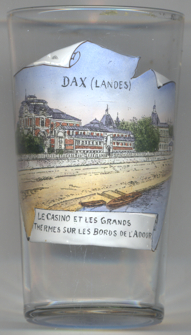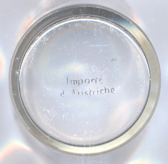

|
| FRANCE | FRANCE |
| région: Nouvelle-Aquitaine | |
| département: 40, Landes |
It was first established by the Romans, and its reputation is supposed to date from a visit by Julia, the daughter
of the first Emperor Octavian Augustus.
Its first name was Aquae Tarbellicae, which later became Acqs, d'Acqs, and finally Dax.
In the Middle Ages, it was administered by viscounts until 1177. With the acquisition of Aquitaine by
Henry II Plantagenet, later King of England, Dax remained under English rule until 1451, when it was
conquered by French troops before the end of the Hundred Years' War. It successfully withstood a Spanish siege
in 1521–1522.
Since antiquity, Dax is reputed for its hot springs. Today, Dax is the second-largest spa town in France,
especially known for mud treatment of rheumatic diseases and similar ailments.
The picture on glass no. 3139 shows a view of
the
Glass no. 3139 is marked at the
[https://de.wikipedia.org/wiki/Dax, https://en.wikipedia.org/wiki/Dax, https://fr.wikipedia.org/wiki/Dax;
http://landesenvrac.blogspot.co.at/2010/01/blog-post_73.html, http://paulinebessonart.wixsite.com/bainssaintpierre-dax/1868-1871-2]
 Dax (Dacs in Occitan) is situated at an elevation of 11 m on the river Adour about 15 km from the Atlantic coast in the
département Landes, région Nouvelle-Aquitaine of southwestern France. Dax is the seat (sous-préfecture) of the
arrondissement of the same name and the seat (bureau centralisateur) of the cantons Dax-1 and Dax-2.
The municipality has a population of about 20,800 (2013).
Dax (Dacs in Occitan) is situated at an elevation of 11 m on the river Adour about 15 km from the Atlantic coast in the
département Landes, région Nouvelle-Aquitaine of southwestern France. Dax is the seat (sous-préfecture) of the
arrondissement of the same name and the seat (bureau centralisateur) of the cantons Dax-1 and Dax-2.
The municipality has a population of about 20,800 (2013).
 Casino
Casino
bottom: Importé d’Autriche.
![[scale]](lineal.jpg)